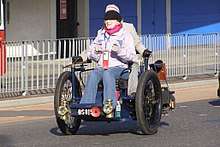Forecar
A Forecar is a body style of small vehicles that were produced in the late 19th and early 20th centuries. Forecars were produced with three or four wheels[1] and by companies which produced light cars or motorcycles.[2][3]

1898 Leon Bollée
1899 De Dion-Bouton
In this type of body, the passenger seat was placed in front of the engine. It was usually placed above the front axle, leaving the occupant extremely vulnerable in the case of a collision.[4] The driver's seat was behind and usually higher than that for the passengers. Weather protection was rarely provided.
On some models the front seat could be replaced by a rack to carry goods, thus converting the car to a light delivery vehicle.[5]
See also
References
- Beattie, Ian (1977). Automobile Body Design. Yeovil, Somerset, UK: Haynes. p. 27. ISBN 0-85429-217-9.
- "1913 H-D Forecar at National Moto Museum". www.motorcycle-usa.com. Retrieved 17 April 2018.
- "Lagonda history". www.thoroughbred-cars.com. Retrieved 17 April 2018.
- "A Short History of Sidecars". www.ridermagazine.com. Retrieved 17 April 2018.
- "June 2008 News". www.motohistory.net. Retrieved 17 April 2018.
| Wikimedia Commons has media related to Category:Forecars. |
This article is issued from Wikipedia. The text is licensed under Creative Commons - Attribution - Sharealike. Additional terms may apply for the media files.